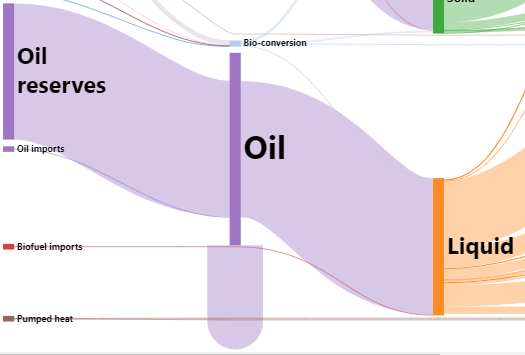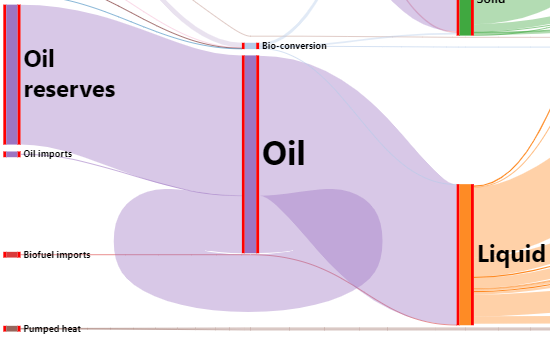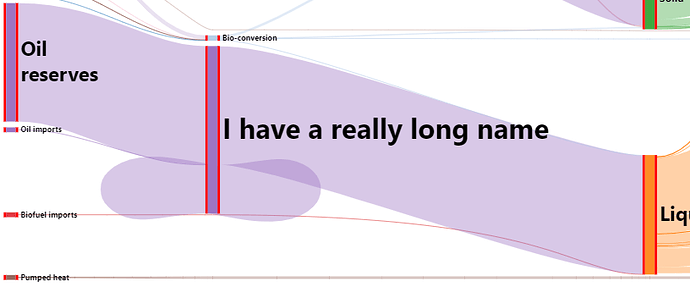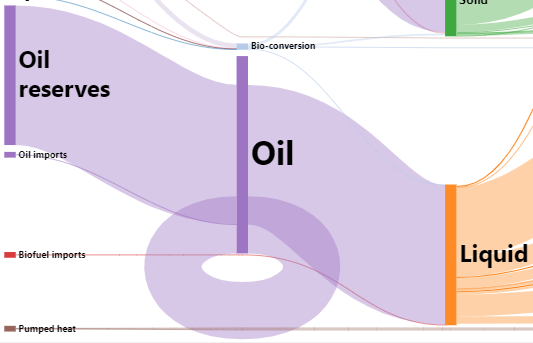Here you go. I also spent some time improving the layout overall, as well as handling multiple reflexive links. It uses a second Shape which is not a port but which acts like one when reflexive Links use the SankeyLink class. Here it is with four reflexive links each with different thicknesses.
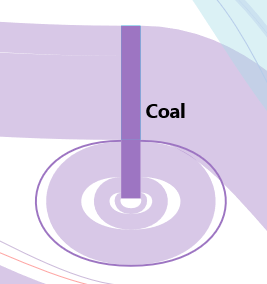
<!DOCTYPE html>
<html>
<head>
<meta charset="UTF-8">
<title>Sankey Diagram with Reflexive Flows</title>
<meta name="description" content="A Sankey diagram with the thickness of links indicating the flow quantity." />
<meta name="viewport" content="width=device-width, initial-scale=1">
<!-- Copyright 1998-2020 by Northwoods Software Corporation. -->
<script src="go.js"></script>
<script src="../assets/js/goSamples.js"></script> <!-- this is only for the GoJS Samples framework -->
<script id="code">
function SankeyLayout() {
go.LayeredDigraphLayout.call(this);
}
go.Diagram.inherit(SankeyLayout, go.LayeredDigraphLayout);
// determine the desired height of each node/vertex,
// based on the thicknesses of the connected links;
// actually modify the height of each node's SHAPE
SankeyLayout.prototype.makeNetwork = function(coll) {
var net = go.LayeredDigraphLayout.prototype.makeNetwork.call(this, coll);
this.diagram.nodes.each(function(node) {
var heights = getAutoHeightForNode(node);
var height = heights[0];
var both = heights[1];
if (height > 0 || both > 0) {
var font = "bold " + Math.max(12, Math.round(height / 8)) + "pt Segoe UI, sans-serif"
var shape = node.findObject("SHAPE");
var shape2 = node.findObject("SHAPE2");
var text = node.findObject("TEXT");
var ltext = node.findObject("LTEXT");
if (shape) shape.height = height;
if (shape2) shape2.height = both;
if (text) text.font = font;
if (ltext) ltext.font = font;
node.ensureBounds();
}
var v = net.findVertex(node);
if (v !== null) {
var r = node.actualBounds;
v.width = r.width;
v.height = r.height + ((both > 0) ? (both + 10) : 0);
v.focusY = v.height/2;
}
});
return net;
};
function getAutoHeightForNode(node) {
var selves = new go.Set(); // remember reflexive links
var heightIn = 0;
var it = node.findLinksInto()
while (it.next()) {
var link = it.value;
if (link.fromNode !== link.toNode) {
heightIn += link.computeThickness();
} else {
selves.add(link);
}
}
var heightOut = 0;
var it = node.findLinksOutOf()
while (it.next()) {
var link = it.value;
if (link.fromNode !== link.toNode) {
heightOut += link.computeThickness();
}
}
var h = Math.max(heightIn, heightOut);
if (h < 10) h = 10;
var heightBoth = 0; // compute total height of reflexive links
selves.each(function(link) {
var sw = link.computeThickness();
heightBoth += sw;
});
var th = heightBoth; // assign curviness for SankeyLink.computePoints
selves.each(function(link) {
var sw = link.computeThickness();
link.curviness = th;
th -= sw;
});
return [h, heightBoth];
};
// treat dummy vertexes as having the thickness of the link that they are in
SankeyLayout.prototype.nodeMinColumnSpace = function(v, topleft) {
if (v.node === null) {
if (v.edgesCount >= 1) {
var max = 1;
var it = v.edges;
while (it.next()) {
var edge = it.value;
if (edge.link != null) {
var t = edge.link.computeThickness();
if (t > max) max = t;
break;
}
}
return Math.max(2, Math.ceil(max / this.columnSpacing));
}
return 2;
}
return go.LayeredDigraphLayout.prototype.nodeMinColumnSpace.call(this, v, topleft);
}
// treat dummy vertexes as being thicker, so that the Bezier curves are gentler
SankeyLayout.prototype.nodeMinLayerSpace = function(v, topleft) {
if (v.node === null) return 100;
return go.LayeredDigraphLayout.prototype.nodeMinLayerSpace.call(this, v, topleft);
}
SankeyLayout.prototype.assignLayers = function() {
go.LayeredDigraphLayout.prototype.assignLayers.call(this);
var maxlayer = this.maxLayer;
// now make sure every vertex with no outputs is maxlayer
for (var it = this.network.vertexes.iterator; it.next();) {
var v = it.value;
var node = v.node;
if (v.destinationVertexes.count == 0) {
v.layer = 0;
}
if (v.sourceVertexes.count == 0) {
v.layer = maxlayer;
}
}
// from now on, the LayeredDigraphLayout will think that the Node is bigger than it really is
// (other than the ones that are the widest or tallest in their respective layer).
};
SankeyLayout.prototype.commitLayout = function() {
go.LayeredDigraphLayout.prototype.commitLayout.call(this);
for (var it = this.network.edges.iterator; it.next();) {
var link = it.value.link;
if (link && link.curve === go.Link.Bezier) {
// depend on Link.adjusting === go.Link.End to fix up the end points of the links
// without losing the intermediate points of the route as determined by LayeredDigraphLayout
link.invalidateRoute();
}
}
};
// end of SankeyLayout
// Implement a custom Link class just to route reflexive links appropriately.
// If your graphs will not have links that connect a node with itself, you do not need this class.
function SankeyLink() {
go.Link.call(this);
}
go.Diagram.inherit(SankeyLink, go.Link);
SankeyLink.prototype.computePoints = function() {
var node = this.fromNode;
if (node === this.toNode) {
// special routing of reflexive links
var p2 = node.findObject("SHAPE2");
if (p2 === null) return false;
var r = p2.getDocumentBounds();
var sw = this.computeThickness();
var curve = isNaN(this.curviness) ? 0 : this.curviness;
var t = r.bottom - curve + sw/2;
var gap = 10;
var e = curve*2 - sw;
var b = r.bottom + gap + curve - sw/2;
this.clearPoints();
this.addPoint(new go.Point(r.right, t));
this.addPoint(new go.Point(r.right + e, t));
this.addPoint(new go.Point(r.right + e, b));
this.addPoint(new go.Point(r.centerX, b));
this.addPoint(new go.Point(r.left - e, b));
this.addPoint(new go.Point(r.left - e, t));
this.addPoint(new go.Point(r.left, t));
return true;
}
return go.Link.prototype.computePoints.call(this);
}
function init() {
if (window.goSamples) goSamples(); // init for these samples -- you don't need to call this
var $ = go.GraphObject.make; // for conciseness in defining templates
myDiagram =
$(go.Diagram, "myDiagramDiv", // the ID of the DIV HTML element
{
initialAutoScale: go.Diagram.UniformToFill,
"animationManager.isEnabled": false,
layout: $(SankeyLayout,
{
setsPortSpots: false, // to allow the "Side" spots on the nodes to take effect
direction: 0, // rightwards
layeringOption: go.LayeredDigraphLayout.LayerOptimalLinkLength,
packOption: go.LayeredDigraphLayout.PackStraighten || go.LayeredDigraphLayout.PackMedian,
layerSpacing: 100, // lots of space between layers, for nicer thick links
columnSpacing: 1
})
});
var colors = ["#AC193D/#BF1E4B", "#2672EC/#2E8DEF", "#8C0095/#A700AE", "#5133AB/#643EBF", "#008299/#00A0B1", "#D24726/#DC572E", "#008A00/#00A600", "#094AB2/#0A5BC4"];
// this function provides a common style for the TextBlocks
function textStyle() {
return { font: "bold 12pt Segoe UI, sans-serif", stroke: "black", margin: 5 };
}
// define the Node template
myDiagram.nodeTemplate =
$(go.Node, "Horizontal",
{
locationObjectName: "BAR",
locationSpot: go.Spot.MiddleLeft,
portSpreading: go.Node.SpreadingPacked // rather than the default go.Node.SpreadingEvenly
},
$(go.TextBlock, textStyle(),
{ name: "LTEXT" },
new go.Binding("text", "ltext")),
$(go.Panel, "Vertical",
{ name: "BAR" },
$(go.Shape,
{
name: "SHAPE",
fill: "#2E8DEF", // default fill color
strokeWidth: 0,
portId: "",
fromSpot: go.Spot.RightSide,
toSpot: go.Spot.LeftSide,
height: 10,
width: 20
},
new go.Binding("fill", "color")),
$(go.Shape,
{
name: "SHAPE2",
fill: "#2E8DEF", // default fill color
strokeWidth: 0,
height: 0,
width: 20
},
new go.Binding("fill", "color"))
),
$(go.TextBlock, textStyle(),
{ name: "TEXT" },
new go.Binding("text"))
);
function getAutoLinkColor(data) {
var nodedata = myDiagram.model.findNodeDataForKey(data.from);
var hex = nodedata.color;
if (hex.charAt(0) == '#') {
var rgb = parseInt(hex.substr(1, 6), 16);
var r = rgb >> 16;
var g = rgb >> 8 & 0xFF;
var b = rgb & 0xFF;
var alpha = 0.4;
if (data.width <= 2) alpha = 1;
var rgba = "rgba(" + r + "," + g + "," + b + ", " + alpha + ")";
return rgba;
}
return "rgba(173, 173, 173, 0.25)";
}
// define the Link template
var linkSelectionAdornmentTemplate =
$(go.Adornment, "Link",
$(go.Shape,
{ isPanelMain: true, fill: null, stroke: "rgba(0, 0, 255, 0.3)", strokeWidth: 0 }) // use selection object's strokeWidth
);
myDiagram.linkTemplate =
$(SankeyLink, go.Link.Bezier,
{
selectionAdornmentTemplate: linkSelectionAdornmentTemplate,
layerName: "Background",
fromEndSegmentLength: 150, toEndSegmentLength: 150,
adjusting: go.Link.End
},
$(go.Shape, { strokeWidth: 4, stroke: "rgba(173, 173, 173, 0.25)" },
new go.Binding("stroke", "", getAutoLinkColor),
new go.Binding("strokeWidth", "width"))
);
// read in the JSON-format data from the "mySavedModel" element
load();
}
function load() {
myDiagram.model = go.Model.fromJson(document.getElementById("mySavedModel").value);
}
</script>
</head>
<body onload="init()">
<div id="sample">
<div id="myDiagramDiv" style="border: solid 1px black; width: 99%; height: 850px"></div>
<p>
A Sankey diagram is a type of flow diagram where the Link thickness is proportional to the flow quantity.
</p>
<div>
<div>
<button onclick="load()">Read</button>
</div>
<textarea id="mySavedModel" style="width:100%;height:250px">
{ "class": "go.GraphLinksModel",
"nodeDataArray": [
{"key":"Coal reserves", "text":"Coal reserves", "color":"#9d75c2"},
{"key":"Coal imports", "text":"Coal imports", "color":"#9d75c2"},
{"key":"Oil reserves", "text":"Oil\nreserves", "color":"#9d75c2"},
{"key":"Oil imports", "text":"Oil imports", "color":"#9d75c2"},
{"key":"Gas reserves", "text":"Gas reserves", "color":"#a1e194"},
{"key":"Gas imports", "text":"Gas imports", "color":"#a1e194"},
{"key":"UK land based bioenergy", "text":"UK land based bioenergy", "color":"#f6bcd5"},
{"key":"Marine algae", "text":"Marine algae", "color":"#681313"},
{"key":"Agricultural 'waste'", "text":"Agricultural 'waste'", "color":"#3483ba"},
{"key":"Other waste", "text":"Other waste", "color":"#c9b7d8"},
{"key":"Biomass imports", "text":"Biomass imports", "color":"#fea19f"},
{"key":"Biofuel imports", "text":"Biofuel imports", "color":"#d93c3c"},
{"key":"Coal", "text":"Coal", "color":"#9d75c2"},
{"key":"Oil", "text":"Oil", "color":"#9d75c2"},
{"key":"Natural gas", "text":"Natural\ngas", "color":"#a6dce6"},
{"key":"Solar", "text":"Solar", "color":"#c9a59d"},
{"key":"Solar PV", "text":"Solar PV", "color":"#c9a59d"},
{"key":"Bio-conversion", "text":"Bio-conversion", "color":"#b5cbe9"},
{"key":"Solid", "text":"Solid", "color":"#40a840"},
{"key":"Liquid", "text":"Liquid", "color":"#fe8b25"},
{"key":"Gas", "text":"Gas", "color":"#a1e194"},
{"key":"Nuclear", "text":"Nuclear", "color":"#fea19f"},
{"key":"Thermal generation", "text":"Thermal\ngeneration", "color":"#3483ba"},
{"key":"CHP", "text":"CHP", "color":"yellow"},
{"key":"Electricity imports", "text":"Electricity imports", "color":"yellow"},
{"key":"Wind", "text":"Wind", "color":"#cbcbcb"},
{"key":"Tidal", "text":"Tidal", "color":"#6f3a5f"},
{"key":"Wave", "text":"Wave", "color":"#8b8b8b"},
{"key":"Geothermal", "text":"Geothermal", "color":"#556171"},
{"key":"Hydro", "text":"Hydro", "color":"#7c3e06"},
{"key":"Electricity grid", "text":"Electricity grid", "color":"#e483c7"},
{"key":"H2 conversion", "text":"H2 conversion", "color":"#868686"},
{"key":"Solar Thermal", "text":"Solar Thermal", "color":"#c9a59d"},
{"key":"H2", "text":"H2", "color":"#868686"},
{"key":"Pumped heat", "text":"Pumped heat", "color":"#96665c"},
{"key":"District heating", "text":"District heating", "color":"#c9b7d8"},
{"key":"Losses", "ltext":"Losses", "color":"#fec184"},
{"key":"Over generation / exports", "ltext":"Over generation / exports", "color":"#f6bcd5"},
{"key":"Heating and cooling - homes", "ltext":"Heating and cooling - homes", "color":"#c7a39b"},
{"key":"Road transport", "ltext":"Road transport", "color":"#cbcbcb"},
{"key":"Heating and cooling - commercial", "ltext":"Heating and cooling - commercial", "color":"#c9a59d"},
{"key":"Industry", "ltext":"Industry", "color":"#96665c"},
{"key":"Lighting & appliances - homes", "ltext":"Lighting & appliances - homes", "color":"#2dc3d2"},
{"key":"Lighting & appliances - commercial", "ltext":"Lighting & appliances - commercial", "color":"#2dc3d2"},
{"key":"Agriculture", "ltext":"Agriculture", "color":"#5c5c10"},
{"key":"Rail transport", "ltext":"Rail transport", "color":"#6b6b45"},
{"key":"Domestic aviation", "ltext":"Domestic aviation", "color":"#40a840"},
{"key":"National navigation", "ltext":"National navigation", "color":"#a1e194"},
{"key":"International aviation", "ltext":"International aviation", "color":"#fec184"},
{"key":"International shipping", "ltext":"International shipping", "color":"#fec184"},
{"key":"Geosequestration", "ltext":"Geosequestration", "color":"#fec184"}
], "linkDataArray": [
{"from":"Coal reserves", "to":"Coal", "width":31},
{"from":"Coal imports", "to":"Coal", "width":86},
{"from":"Coal", "to":"Coal", "width":2},
{"from":"Coal", "to":"Coal", "width":36},
{"from":"Coal", "to":"Coal", "width":16},
{"from":"Coal", "to":"Coal", "width":6},
{"from":"Oil reserves", "to":"Oil", "width":244},
{"from":"Oil imports", "to":"Oil", "width":1},
{"from":"Gas reserves", "to":"Natural gas", "width":182},
{"from":"Gas imports", "to":"Natural gas", "width":61},
{"from":"UK land based bioenergy", "to":"Bio-conversion", "width":1},
{"from":"Marine algae", "to":"Bio-conversion", "width":1},
{"from":"Agricultural 'waste'", "to":"Bio-conversion", "width":1},
{"from":"Other waste", "to":"Bio-conversion", "width":8},
{"from":"Other waste", "to":"Solid", "width":1},
{"from":"Biomass imports", "to":"Solid", "width":1},
{"from":"Biofuel imports", "to":"Liquid", "width":1},
{"from":"Coal", "to":"Solid", "width":117},
{"from":"Oil", "to":"Liquid", "width":244},
{"from":"Natural gas", "to":"Gas", "width":244},
{"from":"Solar", "to":"Solar PV", "width":1},
{"from":"Solar PV", "to":"Electricity grid", "width":1},
{"from":"Solar", "to":"Solar Thermal", "width":1},
{"from":"Bio-conversion", "to":"Solid", "width":3},
{"from":"Bio-conversion", "to":"Liquid", "width":1},
{"from":"Bio-conversion", "to":"Gas", "width":5},
{"from":"Bio-conversion", "to":"Losses", "width":1},
{"from":"Solid", "to":"Over generation / exports", "width":1},
{"from":"Liquid", "to":"Over generation / exports", "width":18},
{"from":"Gas", "to":"Over generation / exports", "width":1},
{"from":"Solid", "to":"Thermal generation", "width":106},
{"from":"Liquid", "to":"Thermal generation", "width":2},
{"from":"Gas", "to":"Thermal generation", "width":87},
{"from":"Nuclear", "to":"Thermal generation", "width":41},
{"from":"Thermal generation", "to":"District heating", "width":2},
{"from":"Thermal generation", "to":"Electricity grid", "width":92},
{"from":"Thermal generation", "to":"Losses", "width":142},
{"from":"Solid", "to":"CHP", "width":1},
{"from":"Liquid", "to":"CHP", "width":1},
{"from":"Gas", "to":"CHP", "width":1},
{"from":"CHP", "to":"Electricity grid", "width":1},
{"from":"CHP", "to":"Losses", "width":1},
{"from":"Electricity imports", "to":"Electricity grid", "width":1},
{"from":"Wind", "to":"Electricity grid", "width":1},
{"from":"Tidal", "to":"Electricity grid", "width":1},
{"from":"Wave", "to":"Electricity grid", "width":1},
{"from":"Geothermal", "to":"Electricity grid", "width":1},
{"from":"Hydro", "to":"Electricity grid", "width":1},
{"from":"Electricity grid", "to":"H2 conversion", "width":1},
{"from":"Electricity grid", "to":"Over generation / exports", "width":1},
{"from":"Electricity grid", "to":"Losses", "width":6},
{"from":"Gas", "to":"H2 conversion", "width":1},
{"from":"H2 conversion", "to":"H2", "width":1},
{"from":"H2 conversion", "to":"Losses", "width":1},
{"from":"Solar Thermal", "to":"Heating and cooling - homes", "width":1},
{"from":"H2", "to":"Road transport", "width":1},
{"from":"Pumped heat", "to":"Heating and cooling - homes", "width":1},
{"from":"Pumped heat", "to":"Heating and cooling - commercial", "width":1},
{"from":"CHP", "to":"Heating and cooling - homes", "width":1},
{"from":"CHP", "to":"Heating and cooling - commercial", "width":1},
{"from":"District heating", "to":"Heating and cooling - homes", "width":1},
{"from":"District heating", "to":"Heating and cooling - commercial", "width":1},
{"from":"District heating", "to":"Industry", "width":2},
{"from":"Electricity grid", "to":"Heating and cooling - homes", "width":7},
{"from":"Solid", "to":"Heating and cooling - homes", "width":3},
{"from":"Liquid", "to":"Heating and cooling - homes", "width":3},
{"from":"Gas", "to":"Heating and cooling - homes", "width":81},
{"from":"Electricity grid", "to":"Heating and cooling - commercial", "width":7},
{"from":"Solid", "to":"Heating and cooling - commercial", "width":1},
{"from":"Liquid", "to":"Heating and cooling - commercial", "width":2},
{"from":"Gas", "to":"Heating and cooling - commercial", "width":19},
{"from":"Electricity grid", "to":"Lighting & appliances - homes", "width":21},
{"from":"Gas", "to":"Lighting & appliances - homes", "width":2},
{"from":"Electricity grid", "to":"Lighting & appliances - commercial", "width":18},
{"from":"Gas", "to":"Lighting & appliances - commercial", "width":2},
{"from":"Electricity grid", "to":"Industry", "width":30},
{"from":"Solid", "to":"Industry", "width":13},
{"from":"Liquid", "to":"Industry", "width":34},
{"from":"Gas", "to":"Industry", "width":54},
{"from":"Electricity grid", "to":"Agriculture", "width":1},
{"from":"Solid", "to":"Agriculture", "width":1},
{"from":"Liquid", "to":"Agriculture", "width":1},
{"from":"Gas", "to":"Agriculture", "width":1},
{"from":"Electricity grid", "to":"Road transport", "width":1},
{"from":"Liquid", "to":"Road transport", "width":122},
{"from":"Electricity grid", "to":"Rail transport", "width":2},
{"from":"Liquid", "to":"Rail transport", "width":1},
{"from":"Liquid", "to":"Domestic aviation", "width":2},
{"from":"Liquid", "to":"National navigation", "width":4},
{"from":"Liquid", "to":"International aviation", "width":38},
{"from":"Liquid", "to":"International shipping", "width":13},
{"from":"Electricity grid", "to":"Geosequestration", "width":1},
{"from":"Gas", "to":"Losses", "width":2}
]}
</textarea>
</div>
This sample demonstrates one way of generating a Sankey or flow diagram.
The data was derived from <a href="https://tamc.github.io/Sankey/">https://tamc.github.io/Sankey/</a>.
</div>
</body>
</html>
